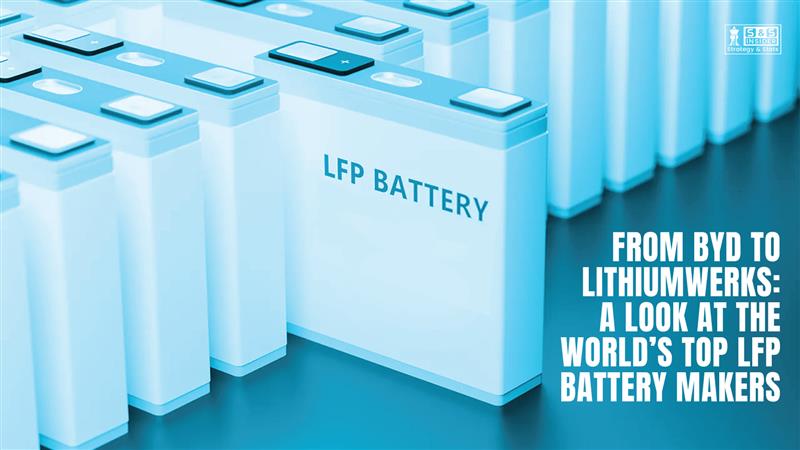
Lithium Iron Phosphate (LFP) batteries have moved from niche use-cases into mainstream energy storage and electric mobility over the past few years. Their combination of long cycle life, intrinsic thermal stability, lower cost raw materials, and improving energy density has made them a preferred chemistry for grid storage, electric buses, entry- to mid-range EVs, and commercial energy systems. Below is a concise look at several notable LFP producers around the world, what they bring to the market and why the chemistry’s rise matters.
Why LFP Matters Today?
LFP chemistry (LiFePO₄) stands out for safety, longevity, and cost-effectiveness. Unlike some other lithium-ion chemistries, LFP is less susceptible to thermal runaway and typically lasts longer in cycle life, which is often a decisive advantage for heavy-duty applications and stationary storage. As battery manufacturers optimize electrode design, cell form factors, and pack-level management systems, LFP’s role continues expanding beyond low-cost segments into higher-value deployments.
Leading Producers of LFP Batteries Globally are:
BYD Company Ltd.
BYD is one of the most prominent names in the LFP story. Starting as a battery maker before becoming a major EV manufacturer, BYD vertically integrates cell production with vehicle and energy business units. This integration gives BYD excellent scale and cost control, and the company has been instrumental in making LFP the go-to chemistry for many mass-market EVs and buses. BYD’s large-scale manufacturing, combined with continuous iteration on cell chemistry and thermal management, has helped push down costs while proving the commercial viability of LFP at fleet scale.
A123 Systems LLC
A123 Systems, historically known for innovations in lithium-ion cell design and high-power nanophosphate cathodes, has been a key player especially in transportation and industrial applications requiring high power and durability. While the company’s roots are in high-power cells, its experience in cell engineering and battery management positions it well to serve markets where robust performance under repeated charge/discharge cycles is essential.
K2 Energy
K2 Energy focuses largely on custom battery solutions for industrial, transportation, and backup-power applications. Companies, such as K2 have helped show the flexibility of LFP chemistry by engineering cells and battery packs tailored for heavy-use environments such as electric buses, forklifts, and telecom backup systems. Their niche expertise often includes deep-cycle designs and ruggedized packs for demanding operating conditions.
Electric Vehicle Power System Technology Co. Ltd.
Manufacturers with names, such as Electric Vehicle Power System Technology typically specialize in integrated power solutions for EVs, starting from cells and modules to battery management systems (BMS) and packs. These companies bridge the gap between raw cell production and vehicle-ready systems, enabling automakers and integrators to deploy LFP technology efficiently. Their work in system integration is critical when scaling LFP into new vehicle segments.
Bharat Power Solutions
Representing the growing energy-tech base in India and other emerging markets, companies such as Bharat Power Solutions focus on domestic energy storage and electrification needs. By adapting LFP products to local grid and transport contexts, these firms support rural and commercial deployments where cost, durability, and safety are paramount. Local manufacturers also help shorten supply chains and reduce dependence on imports for critical energy infrastructure.
OptimumNano Energy Co. Ltd.
OptimumNano is known for its LFP cell production and energy storage solutions, with a portfolio that addresses electric vehicles, commercial energy storage, and residential systems. Firms, such as OptimumNano emphasize both manufacturing scale and modularity, providing cells, modules, and turnkey energy packages to integrators. Their presence highlights the diverse supplier ecosystem in China, which remains a global LFP manufacturing hub.
k2battery
Small- to mid-sized makers and OEMs such as k2battery (listed separately from K2 Energy) illustrate the many specialized suppliers carving out niches in the LFP landscape. These companies often serve regional markets or specialized industrial niches with tailored chemistry tweaks, cell formats, or pack configurations that larger makers might not address.
LiFeBATT Inc.
LiFeBATT has been associated with promoting LFP technology for energy storage and niche mobility applications. Companies with focused portfolios on LFP often provide valuable R&D and market education, helping customers understand how to tune battery management and pack architecture to maximize safety and lifetime, two of LFP’s biggest selling points.
LITHIUMWERKS
Lithium Werks (stylized as LITHIUMWERKS) operates across cell manufacturing and module/system assembly with an emphasis on stationary storage and commercial solutions. Firms like this play an important role in turning cells into integrated systems that deliver predictable performance and meet regulatory and safety standards for grid and industrial deployments.
CENS Energy Tech Co. Ltd.
CENS Energy Tech and similar companies focus on energy systems and battery technologies that align LFP chemistries with renewable integrations and distributed energy resources. Their work often spans turnkey energy storage systems, microgrid integration, and specialized industrial applications, all areas where LFP’s cycle life and safety features are highly valued.
Market Outlook and Challenges:
The LFP market is set to expand as manufacturers continue to scale and innovate. Key drivers include demand for affordable EVs, massive growth in grid-scale storage to balance renewable generation, and regulatory emphasis on battery safety. Challenges remain largely around improving energy density to better compete with nickel-rich chemistries in long-range EVs, securing raw materials supply, and continuing to lower manufacturing cost through automation and cell design improvements.
Conclusion:
LFP producers, from giants, such as BYD to specialized regional firms such as those listed above, are collectively reshaping how the world stores and uses energy. Their combined strengths in safety, cost, and lifecycle performance are making LFP an increasingly attractive choice across transport, commercial, and grid applications. As the ecosystem matures, expect more innovation at the cell and system levels that will broaden LFP’s appeal even further.